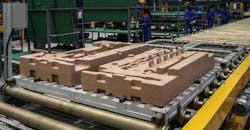New Heating Concept Makes Coremaking More Efficient
Conventional cold-box coremaking operations typically work with process gases – air and an amine-based gas – drawn from separate and gas heating units. The heated gases pass through a series of pipes, through a blow plate, and ultimately into the core box to cure the final products. This arrangement is effective but not efficient because it results in heat loss over the length of the network that the gas transits.
Mingzhi Technology – which operates a coremaking process equipment business near Leipzig, Germany – aims to optimize that gas-heating function, and improve the coremaking process efficiency in other ways too.
“Test data shows that when the set temperature of the air heater is 150°C and that of the amine-based product gas heater is 120°C, the inlet temperature of the blow plate can only reach 70°C,” Minzhi reported, pointing out that the gases lose about 50% of the initial heat at the point of entry to the cure box.
“The low temperature at the inlet of the blow plate creates a poor amine-based product gasification effect, therefore extended blowing time is required for core curing, resulting in low core production efficiency.” Countering the effect requires the foundry operator to raise the amount of amine-based gas, which leads to material waste, unhealthy operating conditions, and greater energy consumption.
The developer’s first proposal was to situate an intermediate heater along the pipeline between the gas generator and the blow plate, to maintain the heat in the amine-based gas. This will address the heat loss to the gas, but does not improve the efficiency of the coremaking process.
Next, it considered consolidating all the heating functions into a compact unit positioned near the blow hood inlet. This minimizes heat loss and space requirements, and it improves the amine-based product gas temperature at the inlet, and makes coremaking more efficient and productive.
The third proposal to address the coremaking process efficiency and productivity is a single, integrated unit that combines the air heater and blow hood. With this, the gas transmission lines are unnecessary, while the loss of heat is minimized and the input gas is delivered to the core box at a stable high temperature. According to Mingzhi Technology, the patented solution improves coremaking efficiency and reduces curing times and energy consumption.
Tests comparing the conventional heating technique with the Mingzhi integrated heater demonstrated that the new approach improved core-curing time and heater power requirements. The data showed that curing times were faster and energy consumption was lower with the integrated heating system in place, pointing to improved process efficiency and environmental impact.
